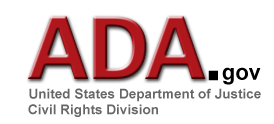
The Americans with Disabilities Act of 1990
and Revised ADA Regulations Implementing Title II and Title III
THE LAW
The Americans with Disabilities Act of 1990 (ADA) prohibits discrimination and ensures equal opportunity for persons with disabilities in employment, State and local government services, public accommodations, commercial facilities, and transportation. It also mandates the establishment of TDD/telephone relay services. The ADA was revised by the ADA Amendments Act of 2008 (P.L. 110-325), which became effective on January 1, 2009. The ADA is codified at 42 U.S.C. 12101 et seq.
THE DEPARTMENT'S ADA IMPLEMENTING REGULATIONS
The Attorney General has responsibility for publishing regulations implementing the requirements of title II (state and local government services) and title III (public accommodations and commercial facilities) of the ADA. The Department originally published its ADA title II and title III regulations on July 26, 1991, including the 1991 ADA Accessibility Guidelines (1991 Standards). The Department’s regulations are located in the Code of Federal Regulations (CFR) at 28 CFR parts 35 (title II) and 36 (title III).
On September 15, 2010 the Department published final regulations revising the Department’s ADA regulations, including the adoption of updated ADA Standards for Accessible Design (2010 Standards). The revised final rules went into effect on March 15, 2011. Compliance with the 2010 Standards was required on March 15, 2012, except that compliance with the requirements in the 2010 Standards with respect to existing swimming pools was subsequently extended to January 31, 2013. (77 FR 30171 (May 21, 2012)).
On July 15, 2016, Attorney General Loretta Lynch signed a Final Rule revising the ADA title II and III regulations to implement the requirements of the ADA Amendments Act of 2008. The Final Rule was published in the Federal Register on August 11, 2016, and took effect 60 days after publication, on October 11, 2016. Congress enacted the ADA Amendments Act to make a number of significant changes to the meaning and interpretation of the ADA definition of “disability” to ensure that the definition of disability would be broadly construed and applied without extensive analysis.
The title III regulation was again revised on November 21, 2016, when Attorney General Loretta Lynch signed a Final Rule that further clarified a public accommodation’s obligation to provide appropriate auxiliary aids and services for people with disabilities. The final rule provides that public accommodations that own, operate, or lease movie theaters are required to provide closed movie captioning and audio description whenever showing a digital movie that is produced, distributed, or otherwise made available with these features. The Final rule was published in the Federal Register on December 2, 2016, and will take effect 45 days after publication, on January 17, 2017.
THE CURRENT ADA REGULATIONS
Title II (State and Local Governments) - HTML | PDF
Title III (Public Accommodations and Commercial Facilities) - HTML | PDF
ADA Amendments Act Final Rule (Signed by the Attorney General on July 15, 2016, published in the Federal Register on August 11, 2016, and took effect 60 days after publication, on October 11, 2016.)
Movie Captioning and Audio Description Final Rule (Signed by the Attorney General on November 21, 2016 and published in the Federal Register on December 2, 2016, and will take effect 45 days after publication, on January 17, 2017.)
THE 1991 REGULATIONS
ADA Regulation for Title II, as printed in the Federal Register on July 26, 1991, and effective until March 15, 2011.
ADA Regulation for Title III, as printed in the Code of Federal Regulations July 1, 1994, and effective until March 15, 2011.




